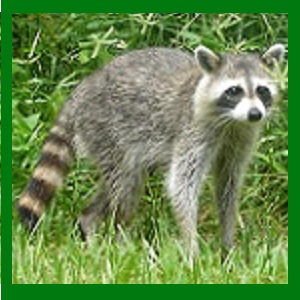Noise in attics is usually raccoons or squirrels gaining access to the roof from tree branches close to the house. Bats, birds, pack rats, mice, flying squirrels, and opossums may also choose to live in an attic if easy access.
It’s best to evict attic guests before spring when they will be having their offspring.
OFWC can remove animals from the attic and do minor repairs to make sure no others move in.

Raccoon Trapping
Raccoons living in the attic, eating your pets food, or being a nuisance on the property?
Old Fort Wildlife Control can remove the raccoons from the property, seal the entry/exit points, and clean up the mess in the attic.
Identification
A raccoon is a small dog-sized mammal with gray/black/silver fur, a black and brown striped tail, and a white face with a black mask over the eyes and nose, At 16-30 in long and 10-40 lbs, it is very agile with front paws as far as carrying and opening things. Raccoons are usually found near water.
Removal
Cage traps are used to catch raccoons where they are causing damage. Raccoons may run in groups so multiple traps may be used around the property. Extra care must be used when setting the traps as raccoons are sometimes hesitant to go in a cage trap.
For females with cubs in an attic, subtle harassment and other deterrents are used to convince mom to take herself and the kids elsewhere. In most cases, cage traps should not be used since the cubs would die without mom, causing a mess in the attic and she will have them hidden very well.
In areas with a high raccoon population, it’s recommended to do trapping and removal in late winter before the females start building nests.
Once the raccoons are removed, repairs can be done so others don’t move in anytime soon.

Squirrel Trapping
Squirrels living in trees around a property are not a problem until they chew holes in the siding and move into the attic. They may make running and jumping noises at odd hours, and chew on boards and wiring.
We can remove squirrels from your attic using exclusion, where they can get out but not back in, or by trapping and relocating.
Identification
Squirrels are members of the rodent family and mostly live in hardwood trees. In our area, there are small gray squirrels and the larger red fox squirrel.
A squirrel is a medium-sized rodent, 10-15 inches long with another 6-10 inches of furry tail. Squirrels in our area are either the smaller gray squirrel (gray in color) or the larger fox squirrel (reddish-brown or orange/brown/grey in color). The squirrel spends most of its time in trees although does come to the ground for traveling or looking for food. Squirrels are most active during the daytime in the early morning or late afternoon. Their primary food source is acorns and tree nuts.
Squirrels may chew holes in siding to get into an attic. Eventually smaller animals like mice and rats may find the holes and larger animals like raccoons.
Removal Method
Squirrels are caught by mounting small cage traps at the entry/exit to the attic. No bait is used, they will be caught when they are coming and going. Since it’s impossible to catch every squirrel in the neighborhood, the goal is to verify that no squirrels are in the attic so repairs can be done. If squirrels are caught, the trap is replaced with an empty one. Once no squirrels are being caught and no noises are being heard, traps are removed and repairs are done.

Bat Exclusions
Bats are present throughout our area and are beneficial by consuming large amounts of insect pests like mosquitos. Bats can become a nuisance when they roost in attics or somehow find their way into houses or buildings. Bats are known to carry rabies and a bite may transfer the disease to humans or pets.
In Arkansas, all bats are considered protected, non-game species and it is illegal to kill them except in the case of potential rabies exposure and the bat needs to be sent to the AR Department of Health.
Our bat control program consists of an initial inspection and population survey to determine the size of the colony, then exclusion using a variety of techniques that allow the bats to leave a structure but not find their way back in. After a period of time when the structure is determined to be bat free, cleanup of the guano can be done.
